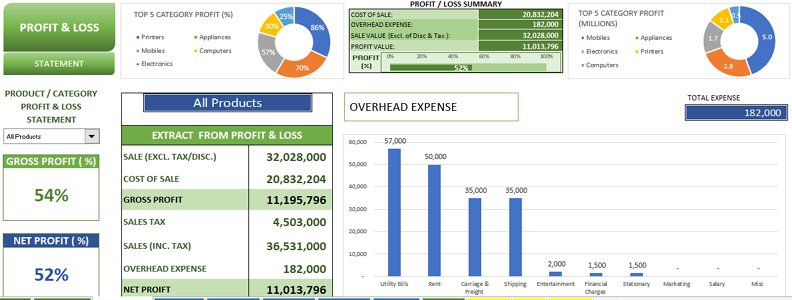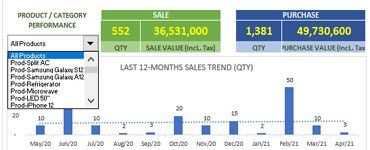Understanding the cost dynamics of your products is crucial for making informed decisions and maximizing profitability. With the Product Cost Analysis Template Excel, you can streamline your cost analysis process and gain valuable insights into your product economics. Let’s explore how this powerful tool can elevate your cost analysis game.
Product Cost Analysis Template Excel is to track and analyze cost during production and sale of the product that include direct cost and indirect cost, direct cost is related to product material, labor and indirect cost is related to factory overheads.
Related Template: Shipment Tracking Template (Order & Delivery)
Features of Product Cost Analysis Template Excel
The Product Cost Analysis Template Excel offers a range of features designed to streamline your cost analysis process. Firstly, it provides a clear and organized layout, facilitating easy navigation and data entry. Additionally, users can input comprehensive cost data, including materials, labor, and overhead, with built-in formulas for automatic calculations.
Moreover, the template offers dynamic analysis tools such as variance analysis and scenario planning, allowing for in-depth insights into cost dynamics. Following are some important points to keep in mind when creating this template
Also Download: Project Portfolio Dashboard
-
Clear Layout for Easy Navigation:
- The Product Cost Analysis Template Excel boasts a user-friendly layout, allowing for effortless navigation and data entry.
- Sections are logically organized, guiding you through the analysis process step by step.
- From inputting cost data to generating insightful reports, every aspect is meticulously arranged for optimal efficiency.
-
Comprehensive Cost Data Input:
- This template provides designated fields for inputting various cost components, including materials, labor, overhead, and other expenses.
- Users can enter cost details for individual products or batches, ensuring accurate and granular analysis.
- Built-in formulas automatically calculate total costs, eliminating the need for manual calculations and reducing errors.
-
Dynamic Cost Analysis Tools:
- Leveraging Excel’s powerful features, the template offers dynamic tools for analyzing cost data from multiple perspectives.
- Users can perform variance analysis, comparing actual costs against budgeted or standard costs to identify discrepancies.
- Interactive charts and graphs visualize cost trends, allowing for easy interpretation and decision-making.
-
Scenario Planning and Sensitivity Analysis:
- With the Product Cost Analysis Template Excel, you can conduct scenario planning and sensitivity analysis to assess the impact of different cost scenarios on profitability.
- By adjusting input parameters such as material prices or production volumes, you can simulate various cost scenarios and evaluate their implications.
- This enables proactive decision-making and risk management, helping you anticipate and mitigate potential cost fluctuations.
-
Customization and Flexibility:
- The template is highly customizable, allowing users to tailor it to their specific business needs and industry requirements.
- You can add or remove cost categories, modify formulas, or incorporate additional analysis tools to suit your preferences.
- This flexibility ensures that the template adapts to your evolving cost analysis needs, providing long-term value and versatility.
Cost comparison analysis template estimated the cost of the competitor, or government project cost and compare it with the cost of our project.
Related Article: Inventory Management System

Download Product Costing Template
Understanding Different Types of Product Costing Methods
Product costing encompasses various methods to determine the total cost of producing a product. Here are the different types of costing methods commonly used:
-
Job Order Costing:
-
Process Costing:
Industries with standardized goods and continuous production processes utilize process costing. In each department or process, a set cost is assigned and then divided among the units produced during a given time period. This technique is perfect for sectors like textiles, food processing, and chemicals.
-
Activity-Based Costing (ABC):
ABC determines and allocates expenses according to the tasks necessary to manufacture a product. By assigning indirect costs to particular operations, it gives a more realistic picture of the factors that influence costs. ABC is especially helpful for companies that have complicated manufacturing procedures or a variety of product lines.
-
Variable Costing:
In variable costing, only the direct labor, direct material, and variable overhead expenses associated with manufacturing are taken into account as product costs. Fixed manufacturing overhead costs are expensed in the period in which they are incurred and are classified as period costs. This approach helps with decision-making for things like price and figuring out how profitable a product is.
-
Absorption costing,
often referred to as full costing, allots all manufacturing expenses, both fixed and variable, to individual goods. Direct labor, direct materials, and variable and fixed manufacturing overhead are all included. According to generally accepted accounting principles, absorption costing is necessary for external financial reporting (GAAP).
-
Standard Costing:
In standard costing, we predetermine the expenses of direct materials, direct labor, and overhead. We then examine the differences by comparing actual expenses to these benchmarks, thus executing production and marketing plans.. This approach makes performance evaluation possible and aids in locating inefficient regions.
-
Marginal Costing:
This method of cost analysis focuses on how expenses behave in relation to variations in production volume. It computes the contribution margin per unit and divides variable expenses from fixed costs. Short-term decision-making and figuring out the breakeven point are aided by marginal costs.
Get Also: Recruitment Tracker Template
Manage Product Cost Life-cycle through Product Cost Analysis Template Excel
The life-cycle of the product starts with the planning and manufacturing of the product and goes on till the product reaches the market for sale. The team undergoes several small steps in the product life cycle. The progress of the team through each step well defines the quality or final outcome of the process.. The product life cycle has these major steps given below;
- In Stage 1: The introductory phase of the life cycle, we bring scope and objectives under consideration. We decide on the marketing strategy and approach in this phase. Additionally, we define the target audience for clarity.
- In Stage 2: The project experiences significant growth, akin to a baby’s development. During this phase, we expect maximum growth. Here, we execute production and marketing plans. The manufacturer by now is clear about the product quality and approach. Therefore, we make amendments to improve the quality and develop a cost-effective product.
- In Stage 3: we manufacture the product and assess its market performance. Not all products perform as expected by the team. However, after receiving the initial response, we can change the marketing strategy to expedite the product’s reach.
- Stage 4: Now is the time to decide the future of the product. You can conclude from the outcomes. If the product is profitable its second batch will be launched if not the product is discontinued.
Related Template: Warehouse and Inventory Management Template
Tracking Spreadsheet in Product Cost Analysis Template Excel
It is important to manage the budget of the project to make it profitable. By using a Product Cost Analysis Template Excel you can easily manage and record the cost of the materials, bills and the wages of the workers. Carefully recording the cost in the Excel spreadsheet ensures that no confusion occurs by the end of the project.
There are different ways and templates available to do the job efficiently. Some project managers track costs on a task basis, while others categorize expenses into direct, indirect, and administrative costs. However, amendments can be made depending on your interest and ease.

Revenue and Expense Analysis Template.
Product Cost Analysis Template Excel The initial step to manage accounts of the company is to keep the balance between income and the expense. All profitable businesses have their expenses somewhat below the income. This rule keeps the cycle smooth. Templates are available which can help you to keep the record;
-
Income and Expense Worksheet
The first column adds the account status along with the date. Including a description provides a quicker insight and update about the account. Additionally, users enter the category, income, and expense. Most importantly, the template calculates the over balance.
Different Examples of the Product Cost Analysis Template Excel
Following are some examples of cost analysis templates.
Cost Benefit Analysis Template
The cost benefit analysis template measures the benefits of actions or decisions minus the costs associated with them.. This analysis used to decrease cost of the product by taking timely decision.
Project Cost Analysis Template
Users utilize this template to analyze the cost of the project in comparison with the project’s benefits. It lists all expenses related to the project and derives the benefits from it once the project is completed.
Download Product Costing with Sales revenue and sales tracking templates
